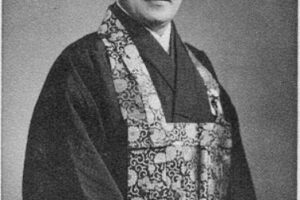
With apologies to Master Huineng, or whomever actually published his biography, which we are studying this month and featuring in our weekly Skype conferences. It occurred to me in reading the rather intimate and detailed recounting of his introduction to the dharma, and his subsequent clarification under Hongren, the Fifth Patriarch of Zen in China, that the peculiar way that I encountered Zen may have some elements of interest. In various writings and interviews elsewhere I have talked about this, so herein I will just touch on some highlights. The platform here, of course, is Mac.
When I met Matsuoka Roshi in Chicago in the 1960s, I was in my mid-twenties, teaching advanced design as well as foundational courses at the School of the Art Institute and the new University of Illinois at Chicago Circle Campus, in my first marriage and with two preschool-age children. So in many ways, I was facing the same issues that many of the 20- and 30-somethings that come to practice Zen are facing today. It is not easy to integrate a sufficiently robust and effective meditation practice with the demands of household, family and career that many face today. On the other hand, it is more difficult to meet our responsibilities at home, work, and in society if we do not have a supportive Zen practice. Zen will get you through times of no (fill in the blank) better than () will get you through times of no Zen. We are all caught on the horns of this dilemma.
In practicing Zen, and zazen, in the pragmatic context of everyday life, it is easy to become confused, and to compartmentalize Zen as just another activity demanding our time. In this way, we also tend to lose sight of the broader and deeper meaning of it. Studying the ancients is one way of remembering this greater truth. Another is to study the self, including reviewing our sometimes painful personal histories.
As a young child with a tendency toward daydreaming and introspection, growing up on a small farm in southern Illinois, and spending a great deal of my time alone, I had the opportunity to learn to entertain myself with very little in the way of outside stimulus. There was no television until I was in high school, no Internet, no computer games, etc.
So when I met my teacher, the experience followed on long years of self-study through the media of art and design; along with musical influences from my father and older brother, both jazz keyboardists; a context of dance from my mother and older sister, the latter who graduated magne cum laude in ballet; and that of other forces such as schooling in the Bauhaus methods of experimentation; as well as like-minded friends and colleagues at work, innovating methods for teaching design in two universities. Thus my orientation was already greatly skewed toward personal discovery, and the need for creative exploration.
Zazen seemed eerily familiar right away, partly owing to the fact that I had been practicing yoga, self-taught, for at least the year prior, and even as a child would stand on my head and do other physical tricks to get attention. In retrospect, it occurred to me that meditation is simply another process of deep immersion, as are the media studies in the Bauhaus tradition and in art. So it wasn’t long before some profound effects set in, seemingly from the influence of zazen. I was not taking any of the psychotropic drugs in vogue amongst my social milieu at the time, though at first I thought that some of my experiences may have amounted to “flashbacks,” a popular concept at that time.
One very strong event occurred while at the zendo one day, which I remember as if in a dream, seeing myself in the picture as if from outside. Standing in the back while we were chanting the sutra, if memory serves, I felt imbued with a pulsing light that filled my field of vision, penetrating in and through everything. Internally, it was more a tactile sensation, in harmony with the visual, and perhaps auditory, though the chanting sound was dominant. At the time, I attributed it to Sensei’s presence. But when alone, it would return to some degree, especially while sitting zazen, and later when I moved to Atlanta, it moved with me.
Many of my students report similar changes in their perception and sensation, which are difficult to describe clearly, as they are on a subtle, nearly subliminal plane. And it should be said that it is not recommended that we become attached to such experiences, nor dwell on them as the purpose and point of our practice. However, such “peeks in the tent” may be necessary to encourage us to continue in the face of sometimes discouraging aspects of everyday life. There is definitely a light at the end of this particular tunnel.
So when we look at the records of our Ancestors, as suggested in Precious Mirror Samadhi (J. Hokyo Zammai), where the great Master Tozan says:
“If you want to follow in the ancient tracks please observe the sages of the past”
we tend to look for clues to what drove them to practice, in admittedly very different circumstances than we face from day to day. In doing so we can free ourselves of the constraints, real or imagined, that those circumstances seem to impose upon our practice, and perhaps glean some insight into the real reasons for engaging in Zen, beyond its amazing power to simply help us cope. If we get caught up in comparative thinking, we may imagine that we must change our present lives to conform to those of the past, suggesting that we abandon our normal daily routines, and escape to a monastery or perhaps a cave in the mountains.
This would be a mistake. The intent of the great master in encouraging us to study the ancients of the past is not to mimic the circumstances or their lifestyles — which would amount to a leap of the imagination in any case — but to emulate their persistence. The next line following reads:
“One on the verge of realizing the buddha way contemplated a tree for ten kalpas”
Ten kalpas is a very long time, covering an infinity of lifetimes, in which the vagaries of life’s circumstances come and go like the momentary changes of the weather. In other words, whatever the circumstances in which we find ourselves, they cannot impede the progress of our Zen practice. It works on a larger scale.
In my professional practice of design I once engaged with a client from Canada called DYLEX. The name is an acronym for “damn your lousy excuses.” This may be a good motto for business, but it is also an appropriate attitude for Zen practice, if self-directed.
Huineng certainly had a lot of excuses, had he wished to avail himself of them. Poor, illiterate, no prior experience in meditation — not a prime candidate for head honcho of Zen. But he did not allow all his obvious defects to deter him. In spite of, rather than because of them, he persisted. It had to take a lot of grit and determination just to travel to Hongren’s monastery in those days, on foot. Especially when the most he could expect was to be rejected and humiliated. So he had to have some faith in Hongren, if he was the person he was reputed to be, to see beyond the surface of things, including his superficial attributes of personality. Fortunately his confidence was well-placed, his faith rewarded, and within nine months Hongren sent him packing to the South, as his successor, robe and bowl in hand. He had to be a 20-something at the time.
Like Huineng, as a near-thirty-something, I headed south in 1970, at the same time that when Matsuoka Roshi headed west, not knowing how and when I would be able to reconstitute my Zen practice. I would be busy rebuilding my life with a new job, new social circle, and managing long-distance relationships with my Zen teacher, ex, and children. Zen had to be put on the back burner for a while, at least in terms of any substantial commitment of time to propagating it. I “kept my light under a bushel” as did Huineng, coincidentally for about the same amount of time, if not for the same reasons. To my knowledge, no one was in pursuit to murder me and return the robe and bowl to its rightful owner. I had other demons pursuing me, of course, as we all do.
After about four years of re-establishing my situation, ending another relationship, and changing careers yet again, I began teaching Zen publicly, at the largest Unitarian church in Atlanta, Cliff Valley UU Congregation, around 1974. The Atlanta Soto Zen Center was incorporated in 1977 and the rest, as they say, is history.
Like Matsuoka Roshi, and Huineng before him, I had no clear idea of what I was doing. That is, there was no master plan for leading a Zen life in some preconceived way, let alone establishing a Zen center and a network of affiliated practice groups. It was seat-of-the-pants all the way, no pun intended. I believe that we all have to reinvent Zen in this sense, to tailor it to our particular, and sometimes very peculiar, circumstances.
This is part of the surpassing ingeniousness of Zen. It is of such simplicity of design and implementation that it can fit anywhere, much like the aspects attributed to “It” by Master Tozan’s “mirror”:
“So minute it enters where there is no gap; so vast it transcends dimension”
Zen fits in anywhere and at anytime; we really have no excuses. But the next, cautionary line indicates the extreme difficulty of reaching this It, and of actualizing it in daily life:
“A hairsbreadth deviation and you are out of tune”
Note that you are out of tune. It is not the fault of Zen if it is not working for you. We are called upon to creatively engage this ancient practice, finding workarounds in our daily life, sidestepping and otherwise disabling those aspects of life that tend to get in the way. Most especially, those hurdles that we tend to throw into our own way. They are all part of the Path, which is one meaning of no Path. If there is no path, we can neither enter it nor leave it; there is no way of actually being out of tune with this signal.
In closing let me encourage you to meet and embrace the difficulties of your life, self-imposed and imposed by others, with the same zeal that these Four Horsemen of China — Master Sengcan, Master Huineng, Master Sekito Kisen, and Master Tozan — exerted; and surely under conditions that were even more demanding than those we face today. Don’t give up was Matsuoka Roshi’s constant admonition, and he meant it precisely in the context of all the excuses you may find for giving up. In truth, we cannot give up our practice; we can only change it for the better or for the worse. We either do Zen well or we do it poorly; we cannot not practice Zen, even if we never heard of it. Huineng is proof of this.








